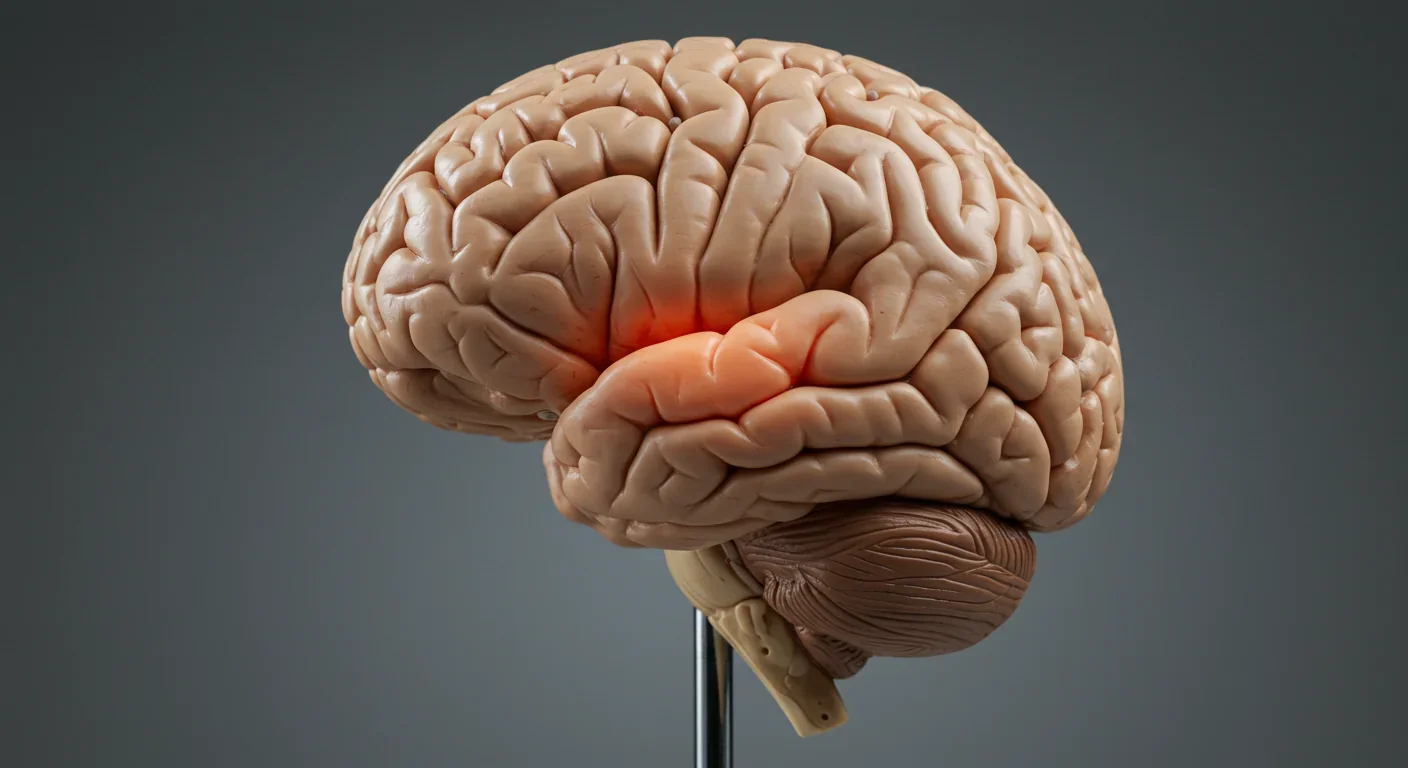Why Your Brain Sees Gods and Ghosts in Random Events

TL;DR: Your brain treats false beliefs like physical realities, carving them into neural pathways through dopamine rewards, repetition, and emotional reinforcement. Understanding these mechanisms can help you recognize and overcome cognitive biases.

What happens when your brain treats a lie like it's the truth? New research shows that within your skull, false beliefs aren't just wrong ideas—they're physical realities, carved into neural pathways as real as any memory of your childhood. Scientists now understand that questioning a deeply held belief can be literally hurtful, triggering the same brain regions associated with physical pain. This isn't metaphorical discomfort. Your amygdala lights up, your prefrontal cortex dims, and your body reacts as if someone just threatened your survival.
Your brain isn't a truth-seeking machine—it's a pattern-recognition device optimized for survival, not accuracy. Neuroimaging studies reveal that no single 'mind-reading' area exists for processing beliefs. Instead, a distributed network spans the medial prefrontal cortex, temporo-parietal junction, superior temporal sulcus, and amygdala. Each region plays a distinct role in constructing what you accept as true.
The prefrontal cortex handles decision-making and cognitive control. The amygdala tags experiences with emotional weight, making some memories stick harder than others. The temporo-parietal junction helps you understand other people's perspectives—or misunderstand them spectacularly when bias kicks in.
Here's where it gets unsettling: EEG studies show conspiracy believers exhibit reduced beta oscillatory activity in the frontal cortex, the very region responsible for rational evaluation. Lower frontal beta activity means weaker cognitive brakes. Your brain makes associative leaps more easily, connecting dots that don't actually form a picture.
When researchers examined people holding conspiracy theories about HIV origins or election fraud, they found something remarkable: these believers weren't stupid or uneducated. Their brains simply processed information differently, with reduced activity in areas that normally filter implausible connections.
Dopamine isn't just the pleasure chemical—it's the brain's primary motivator, driving everything from your morning coffee craving to your political convictions. Dopamine is produced in the midbrain and projects to the prefrontal cortex and nucleus accumbens, creating a reward circuit that reinforces behaviors and beliefs.
Every time you encounter information that confirms what you already think, your brain gets a dopamine hit. It feels satisfying, like scratching an itch. Contradictory information? That triggers discomfort, sometimes activating the same neural pathways as physical pain.
The reward system creates a vicious cycle. Repeated dopamine spikes raise your threshold, reducing future satisfaction from ordinary evidence. You need stronger, more dramatic confirmation to feel that same rush. This explains why people spiral deeper into extreme beliefs—they're chasing the dopamine dragon.
Social media platforms exploit this perfectly. Digital platforms use 'intermittent reward scheduling' to keep users scrolling, delivering unpredictable bursts of validation. Every like, share, or comment that agrees with your worldview triggers dopamine release. Your brain learns: engaging with like-minded content equals reward.
This isn't a character flaw. It's neurochemistry. Your ventral tegmental area doesn't care about truth—it cares about prediction error. When reality matches your belief, dopamine flows. When reality contradicts your belief, the signal drops, and your brain interprets that as something's wrong with reality, not your belief.

Tell someone the same lie twenty-seven times, and something eerie happens in their brain. Researchers tested this by exposing participants to false statements up to 27 times. The result? People rated obviously ridiculous claims as more truthful simply because they'd heard them before.
This is the illusory truth effect in action, and it has measurable neural consequences. Repeated exposure to false information creates neural pathways that strengthen belief, making them progressively harder to undo. Each repetition carves the pattern deeper into your cortex.
Your brain uses a shortcut called processing fluency. Familiar information feels easier to process, and your brain misinterprets that ease as accuracy. The twentieth time you hear "vaccines cause autism" or "the election was stolen," it flows through your neural networks more smoothly than the first time. That fluency tricks your evaluation system into thinking it must be true.
Memory systems compound the problem. Functional MRI studies show false memories activate regions like the medial temporal lobe and anterior cingulate cortex—similar to real ones. Your hippocampus stores the false memory with the same neural signature as genuine experiences. When you recall it later, you can't tell the difference.
The amygdala makes it worse. The amygdala amplifies emotionally charged memories, cementing dramatic conspiracy narratives more firmly than boring facts. A scary story about government cover-ups sticks better than a nuanced explanation of institutional failure, because your amygdala tags the conspiracy with emotional weight.
Confirmation bias isn't just selective attention—it has measurable neurological correlates visible in brain imaging studies. When you encounter information supporting your existing belief, different neural circuits activate than when you face contradictory evidence.
Your brain literally processes agreeable information and disagreeable information through different pathways. Agreeable information gets a fast pass through reward circuits. Disagreeable information triggers threat detection systems, activating the amygdala and sometimes the anterior cingulate cortex—regions involved in conflict monitoring and emotional distress.
This creates an asymmetric battlefield. Evidence confirming your belief feels like relief, validation, safety. Evidence contradicting your belief feels like attack, confusion, pain. Over thousands of decisions, this asymmetry shapes what information you seek, remember, and integrate into your worldview.
Algorithms turbocharge this process. Algorithms that personalize content amplify repetition, creating echo chambers that expedite neural consolidation of false beliefs. Your YouTube recommendations, Facebook feed, and Twitter timeline all learn to serve you content that keeps you engaged—which means content that confirms what you already think.
The result? False information spreads six times faster than true information on social media. Lies are more novel, more emotionally charged, more shareable. Truth is often boring, complex, and unsatisfying. Your brain's reward systems prefer the lie.
Imagine holding two contradictory beliefs at once. Your brain hates this. Cognitive dissonance functions like an internal alarm—an 'Error 404' that signals inconsistency between beliefs and behavior.
Your brain craves consistency, predictability, and alignment. When reality contradicts your belief, you experience psychological tension. Brain imaging shows that encountering challenges to established beliefs activates areas associated with physical pain, prompting defensive emotional responses.
The standard resolution? Change your belief to match reality, right? Not quite. The limbic brain often overrides the prefrontal cortex when a belief is challenged, producing guilt and anxiety that paradoxically reinforce the false belief. Your emotional system shouts louder than your logical system.
People raised in abusive environments show an extreme version of this. Complex trauma rewires the brain so the limbic system constantly signals threat when the individual engages in healthy behaviors, leading to chronic false guilt. Their brains learned to distrust accurate signals and trust harmful narratives, because that's what kept them safe as children.
This isn't limited to trauma survivors. We all experience versions of this dynamic. When health officials said masks work, then said they don't, then said they do, many people's brains resolved the dissonance by rejecting the entire institution rather than tolerating uncertainty.
Emotions aren't bugs in your reasoning system—they're features, essential for decision-making. Research on patients with brain damage reveals this clearly. Damage to the ventromedial prefrontal cortex impairs decision-making by preventing the use of somatic signals that guide advantageous choices.
In the Iowa Gambling Task, participants choose from card decks with different risk-reward profiles. Healthy people develop "gut feelings" about which decks are dangerous, measurable as skin conductance responses before they consciously know the pattern. Patients with amygdala damage showed no anticipatory responses and performed poorly on the task.
Without emotional signals, you can't make good decisions. The somatic marker hypothesis proposes that your body's emotional reactions—the tightness in your chest, the flutter in your stomach—tag options as good or bad before your conscious mind analyzes them. When those signals are absent or miscalibrated, you make consistently poor choices despite knowing better intellectually.
This explains why purely rational arguments rarely change minds. Facts activate your prefrontal cortex. But beliefs are reinforced by emotional circuits that evolved to keep you alive, not accurate. Your amygdala doesn't care if the threat is real—it cares if the threat feels real.

Intelligence doesn't protect against false beliefs—sometimes it makes them worse. Smarter people are better at constructing elaborate justifications for what they already believe. They have more knowledge to cherry-pick from, more rhetorical skill to defend positions, more cognitive resources to rationalize contradictions.
One fascinating case study examined a patient with frontotemporal dementia who showed highly utilitarian choices in altruistic scenarios despite severe socioemotional and executive deficits. This suggests different moral intuitions map to separable neural circuits. The patient's capacity for impartial beneficence remained intact even as other judgment systems degraded.
This hints at something broader: your belief systems aren't unified. They're collections of semi-independent modules, each supported by different neural substrates. Political beliefs might rely heavily on social identity circuits. Religious beliefs might engage different networks related to meaning-making and existential anxiety. Health beliefs might depend more on trust circuits and risk assessment.
When someone holds a false belief in one domain but demonstrates excellent reasoning in others, it's not hypocrisy—it's modularity. The neural networks supporting their climate skepticism might be completely separate from those supporting their excellent engineering judgment.
Humans evolved as social creatures, and your brain prioritizes group cohesion over individual accuracy. The mentalizing network or social brain lights up when we think about what others believe, want, or feel, and this network is vulnerable to groupthink.
When your social group adopts a belief, powerful neural mechanisms push you to conform. Disagreeing with the group triggers social pain circuits—some of the same regions activated by physical pain or social rejection. Agreeing triggers reward circuits and the release of oxytocin, the bonding hormone.
This creates a terrible incentive structure. Challenging false beliefs held by your community risks social rejection, which your brain interprets as an existential threat. In our evolutionary past, exile from the tribe meant death. Your amygdala still treats social rejection with similar urgency, even though modern exile usually just means awkward Thanksgiving dinners.
Political tribalism exploits this mercilessly. When beliefs become identity markers, questioning them feels like questioning your worth as a person. Your brain's self-concept systems become entangled with your political positions, making disconfirmation of a policy preference feel like disconfirmation of your fundamental self.
Despite these powerful forces, your brain retains neuroplasticity—the ability to rewire itself. Change is possible, but it requires understanding how your neural systems work so you can work with them, not against them.
Prebunking works better than debunking. Exposing people to weakened forms of misinformation can inoculate against future deceptive content, similar to how vaccines work. When you encounter a manipulative technique in a safe context first, your brain builds resistance.
Diverse information sources help counteract echo chambers. Deliberately seeking views you disagree with—not to argue, but to understand—activates different neural pathways than passive consumption of agreeable content. This doesn't mean giving equal weight to nonsense, but it means understanding the best versions of opposing arguments.
Metacognitive awareness means thinking about your thinking. When you notice yourself feeling defensive about an idea, that's your amygdala talking. When information feels immediately true because it's familiar, that's processing fluency, not accuracy. Learning to recognize these neural shortcuts lets you apply conscious override.
Reset dopamine baselines through routine activities. Sleep, nutrition, and exercise help reset dopamine levels and reduce impulsivity, making you less vulnerable to addictive information patterns. A brain that isn't dopamine-depleted is better at resisting manipulative content.
Emotional regulation skills matter enormously. When encountering contradictory information triggers your threat response, techniques like deep breathing, progressive muscle relaxation, or mindfulness can calm your amygdala enough for your prefrontal cortex to engage. You can't think clearly when your limbic system is screaming.
Social connection outside echo chambers provides real-world feedback. When your beliefs are tested not by abstract arguments but by relationships with real humans who see things differently, different neural systems engage. Your social brain wants connection, which can sometimes override your tribal loyalty circuits.
We're running Paleolithic brains on a digital information ecosystem they never evolved for. Your ancestors needed to trust their tribe, spot patterns quickly, and avoid contradicting the alpha. Those same neural systems now navigate an environment where false information spreads six times faster than truth, where algorithms optimize for engagement rather than accuracy, where foreign actors and domestic manipulators exploit your cognitive biases at scale.
The solution isn't just individual mental discipline, though that helps. It requires redesigning information systems to work with human neuroscience rather than against it. Platforms could slow sharing to disrupt the intermittent reward scheduling that makes misinformation addictive. Algorithms could prioritize accuracy over engagement, even at the cost of user time on site. Communities could establish norms that reward intellectual humility over confident wrongness.
Some countries are experimenting with digital literacy programs that teach recognition of manipulation techniques. Finland's education system includes media literacy from elementary school onward, helping children develop metacognitive skills before their beliefs calcify. Early results suggest this approach works—Finnish citizens show higher resistance to propaganda and misinformation.
The neuroscience community itself bears responsibility. Research on belief formation, memory consolidation, and bias has mostly stayed within academic circles, when it desperately needs wider application. Platform designers need to understand how repetition rewires neural pathways. Educators need to know why emotionally charged misinformation sticks harder than boring facts. Policy makers need to grasp how confirmation bias has measurable neural correlates.
Understanding the neuroscience of belief doesn't magically make you immune to these forces—your amygdala doesn't care that you read an article explaining how it works. But awareness creates possibility. When you feel that rush of righteous certainty, you can pause and ask: is this dopamine talking? When contradictory evidence triggers discomfort, you can recognize it as cognitive dissonance rather than proof the evidence is wrong.
Your brain will always prefer patterns that feel good over patterns that are true. Evolution built it that way. The question is whether you'll accept that default programming or learn to hack your own source code.
False beliefs aren't character flaws—they're features of a neural architecture optimized for tribal survival in small groups on the African savanna. You're not broken for believing wrong things sometimes. You're human, running ancient wetware in a modern world.
The real test isn't whether you hold false beliefs—everyone does. It's whether you can create conditions where your brain occasionally lets them go.

Recent breakthroughs in fusion technology—including 351,000-gauss magnetic fields, AI-driven plasma diagnostics, and net energy gain at the National Ignition Facility—are transforming fusion propulsion from science fiction to engineering frontier. Scientists now have a realistic pathway to accelerate spacecraft to 10% of light speed, enabling a 43-year journey to Alpha Centauri. While challenges remain in miniaturization, neutron management, and sustained operation, the physics barriers have ...

Epigenetic clocks measure DNA methylation patterns to calculate biological age, which predicts disease risk up to 30 years before symptoms appear. Landmark studies show that accelerated epigenetic aging forecasts cardiovascular disease, diabetes, and neurodegeneration with remarkable accuracy. Lifestyle interventions—Mediterranean diet, structured exercise, quality sleep, stress management—can measurably reverse biological aging, reducing epigenetic age by 1-2 years within months. Commercial ...

Data centers consumed 415 terawatt-hours of electricity in 2024 and will nearly double that by 2030, driven by AI's insatiable energy appetite. Despite tech giants' renewable pledges, actual emissions are up to 662% higher than reported due to accounting loopholes. A digital pollution tax—similar to Europe's carbon border tariff—could finally force the industry to invest in efficiency technologies like liquid cooling, waste heat recovery, and time-matched renewable power, transforming volunta...

Humans are hardwired to see invisible agents—gods, ghosts, conspiracies—thanks to the Hyperactive Agency Detection Device (HADD), an evolutionary survival mechanism that favored false alarms over fatal misses. This cognitive bias, rooted in brain regions like the temporoparietal junction and medial prefrontal cortex, generates religious beliefs, animistic worldviews, and conspiracy theories across all cultures. Understanding HADD doesn't eliminate belief, but it helps us recognize when our pa...

The bombardier beetle has perfected a chemical defense system that human engineers are still trying to replicate: a two-chamber micro-combustion engine that mixes hydroquinone and hydrogen peroxide to create explosive 100°C sprays at up to 500 pulses per second, aimed with 270-degree precision. This tiny insect's biochemical marvel is inspiring revolutionary technologies in aerospace propulsion, pharmaceutical delivery, and fire suppression. By 2030, beetle-inspired systems could position sat...

The U.S. faces a catastrophic care worker shortage driven by poverty-level wages, overwhelming burnout, and systemic undervaluation. With 99% of nursing homes hiring and 9.7 million openings projected by 2034, the crisis threatens patient safety, family stability, and economic productivity. Evidence-based solutions—wage reforms, streamlined training, technology integration, and policy enforcement—exist and work, but require sustained political will and cultural recognition that caregiving is ...

Every major AI model was trained on copyrighted text scraped without permission, triggering billion-dollar lawsuits and forcing a reckoning between innovation and creator rights. The future depends on finding balance between transformative AI development and fair compensation for the people whose work fuels it.